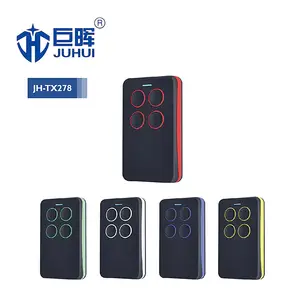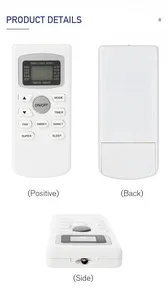(19704 products available)
















































































































































































































The remote controller is a device used to control other machines from a distance. It has become a significant necessity in modern society. There are several types of remote controllers, which vary based on application, design, features, and functionality.
Remote Control Car:
These are toy cars controlled remotely using a handheld transmitter. The intended age of use varies from young kids to adults. They are commonly used for play, competition, and hobby. Their size can range from micro to large-scale models.
Remote Control Boat:
Like remote control cars, these boats are toy boats controlled using a transmitter. They can be used in calm water bodies like ponds, lakes, and swimming pools. Remote control boats can be cars or trucks transformed to run on water, or they can be boated designed for water channels. Their operation may involve some degree of skill.
Universal Remote Control:
This remote control can be made to control various devices from different brands. It was designed as a solution to the problem of having many remotes for various equipment in a household or complex. Universal remote controls are made to replace the original remote that comes with the device. It's worth noting that not all universal remote controls are compatible with all devices. Nonetheless, they can control TVs, DVD players, sound systems, and other electronic devices.
Key Fob:
Most modern key fobs have remote controls that allow users to lock and unlock the doors of the car. Some even have panic buttons. Key fobs also provide keyless ignition. They have sensors that detect when the driver is inside the car. In the past, key fobs used infrared technology. However, nowadays, they use radio frequency identification (RFID) or near-field communication (NFC).
Remote Control for Drones:
Drone remote controls usually resemble gamepads. Most have smartphone holders to enable live viewing. The drone remote control is used to steer the drone and control its speed and altitude.
Walkie Talkie:
Commonly referred to as a two-way radio, the walkie-talkie is a portable device that can transmit and receive voice. It's strategically designed to be held with one hand while pressing a button to speak. When the button is released, the user can hear other people speaking. The walkie-talkie can be classified as a remote control due to its two-way communication. Its application ranges from personal to professional use.
Remote controllers are important devices that have many functions and features. They control equipment from a distance, thus eliminating the need to manually operate the machine. Most people use it to change channels on televisions, adjust the volume, or turn the set on and off.
Manufacturers equip remote controllers with sensors like an IR that transmits signals to the controlled device. Bluetooth and RF remote controls don't need a line of sight and can operate gadgets within a certain radius.
Bulk remote control purchases are becoming popular among businesses that need them for various applications. Many industries rely on remote controllers to manage devices and enjoy their functionality and convenience. Knowing the principal applications of remote controls can help merchants identify areas with a high demand for such products.
Consumer Electronics
TV and Media Remotes: There are countless applications for remote controllers in the typical household. Most people use remote controls to manage sound systems, televisions, streaming devices, and media players. These busy gadgets have made reмote controllers integral to normal consumer electronics.
Gaming and VR: The gaming industry relies heavily on remote controllers. Xbox One controllers and PlayStation DualSense wireless controllers are some examples of popular game remotes. Gamers also use remotes in virtual reality (VR) environments for navigation and gameplay.
Home and Office
Smart Home Devices: Modern smart home gadgets all come with remote controls. Homeowners can control their smart thermostats, security cameras, door locks, lights, and other assistants like Amazon Echo and Google Home remotely.
Office Presentations: Air mouse remote controllers are a must-have for offices and corporate environments. They allow seamless device control during meetings and presentations. Also, digital signage and interactive kiosks rely on remotes for content navigation and display control.
Industrial Applications
Machinery Control: Many industrial machines found in production assemblies depend on remote controls. Belt conveyors, cranes, mixers, and other machines have remote controllers for operator safety and increased productivity. Operators can control and monitor equipment from a distance, which significantly reduces hazards and boosts efficiency.
Facility Management: Facility managers use remote controls to oversee security systems, lighting, HVAC (heating, ventilation, and air conditioning) systems, and other building support equipment.
Automotive and Transportation
Vehicle Systems: Modern cars come with remote controls for various systems and amenities, including keyless entry, engine start, adaptive cruise control, and key fobs. Also, car owners use remote apps to control vehicle functions from their smartphones.
Public Transport: Buses, trains, and other forms of public transport now come with remote controls for seat entertainment systems and lighting controls.
Healthcare and Accessibility
Medical Devices: In today's healthcare environment, remote controls have become a standard for managing medical gadgets. Healthcare providers use them to adjust settings on mobility devices, patients’ beds, vital signs monitors, CPAP (Continuous Positive Airway Pressure) ) machines, and many more from a distance.
Remote controls are also a game-changing accessibility tool for people with mobility challenges. Persons with disabilities can control TVs, smart home devices, and other electronics from their phones with voice-activated remotes.
Wholesale buyers need to carefully choose manufacturers who can supply them with reliable and programmable remote controllers in good quantity and consistently. Here are some of the main things to consider when selecting a supplier:
Manufacturer's Reputation and Experience:
A reputable supplier with many years of experience in the consumer electronics market will understand market trends and demands. Remote controllers are extremely sensitive to programmable features, so the supplier should have robust production and quality control processes to ensure consistent quality.
Product Quality:
Look for suppliers that offer high-quality products built to last. Do they have quality certification? Do they have independent testing to verify the product's performance? If they have, it is a good sign that they are committed to product quality.
Diverse Product Range:
Choose suppliers that have a wide range of products to meet the different needs of customers. Products with various features, designs, and compatibility can attract more customers to one business. A supplier that provides remote controllers for various devices will be useful to one business because the supplier will be up to date with changes in technology.
Customization Options:
If a business needs a custom remote control, choosing a supplier that can provide customization options is important. To meet specific requirements, the custom option should allow one to change features, design, and branding.
Warranty and After-sales Support:
A good warranty shows that a supplier is confident in the quality of their product. Supplying businesses with remote controllers should have clear terms and conditions for taking care of faulty products. Also, effective after-sales support helps to quickly solve any problems that arise after the sale.
MOQs and Production Capability:
Minimum order quantity (MOQ) varies from one supplier to another. Be sure to choose a remote controller supplier that has an MOQ that meets one's needs. Also, one should examine the production capability of the supplier to make sure they can meet the demand in order to send the order rapidly and consistently.
Q1: What are the current trends in remote control technology?
A1: The latest trends include voice controls, smartphone connectivity, personalized remotes, and RF/BT technologies.
Q2: What challenges are faced when designing remote controls?
A2: Ensuring durability, providing intuitive usability, and integrating multiple technologies are some challenges manufacturers face.
Q3: What is the average lead time for ordering custom remotes?
A3: Lead times vary based on quantity and complexity, but remotes typically take several weeks to manufacture.
Q4: How should custom remote controls be stored?
A4: Keep controllers in a cool, dry place, away from direct sunlight and extreme temperatures to store them properly.